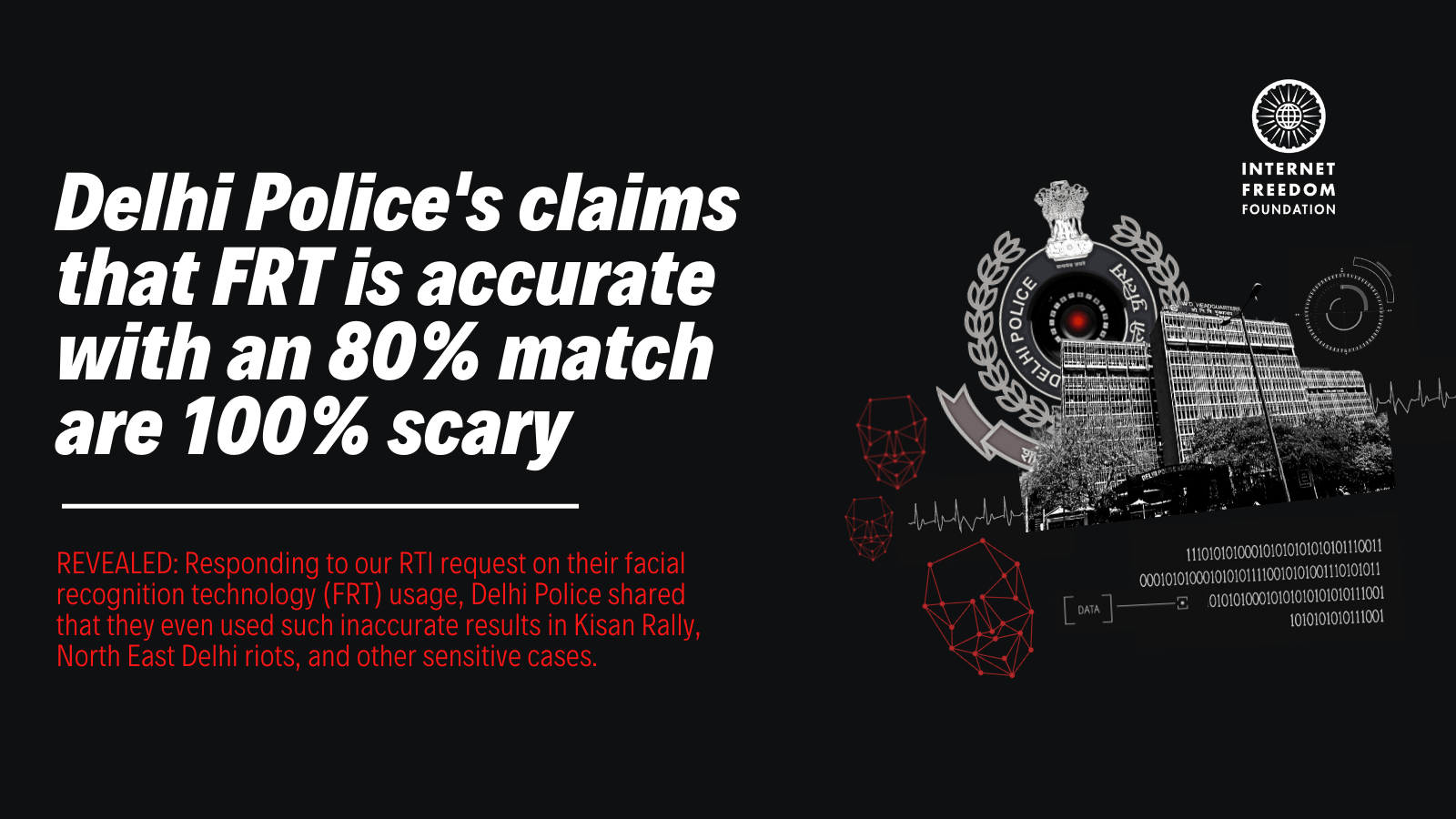
tl;dr
After being directed by the Central Information Commission to respond afresh to our RTI requests seeking information on use of facial recognition (FRT) in policing, the Delhi Police has revealed that it treats all results above 80% similarity as positive results. Read our analysis of the responses received below.
RTI responses shine new light on how the Delhi Police uses FRT
In 2020 and 2021, we filed three RTI requests with the Delhi Police seeking information on their use of FRT. The information was refused under Section 8 of the RTI Act. Some information was refused on the ground that it is not available. The Delhi Police also said they have “Nil” information on CCTV cameras! Our first appeals against these responses were rejected, so we filed Second Appeals with the Central Information Commission. They were heard on June 29, 2022, and the Delhi Police were directed to revise their response to the RTI applications, in compliance with the RTI Act. (Read more about the CIC proceedings here)
Through replies dated July 25, 2022, the Delhi Police has finally revealed some of the information we had sought in our requests.
- The Delhi Police used FRT to investigate the North East Delhi riots, the Kisan Rally (Lal Qila Riots), and the Jahangir Puri Riots cases.
- The accuracy of their FRT depends on light conditions, distance, and angle of face. All matches above 80% similarity are treated as positive results while matches below 80% similarity are treated as false positive results which require additional “corroborative evidence”.
- The Delhi Police uses convict photographs and dossier photographs under S.3 & 4 of the Identification of Prisoners Act, 1920.
- In response to our query whether the FRT data will be used as evidence, the Delhi Police has replied in the affirmative however has refused to share further information citing S. 8(1)(h) of the RTI Act.
- The Delhi Police has also indicated that FRT is “being widely used in solving cases specially pertaining to heinous cases and missing persons and also in Unidentified Bodies and Unidentified person found (sic)”.
- In response to our query pertaining to whether any privacy impact assessment was carried out, the Delhi Police responded in the negative, however they have stated that “the privacy of any citizen is sacrosanct and the Delhi Police is well aware of that”.
The information revealed allows us much greater understanding about how the Delhi Police is using facial recognition. Firstly, it is unclear why 80% has been chosen as the threshold between positive and false positive. It is unclear why the Police believes that above 80% is sufficient to assume the results are correct and no justification has been provided for this classification. Secondly, the distinction between categorisation of below 80% results as false positive instead of negative shows that the Delhi Police may still try to use below 80% results for further investigation by trying other methods of "corroborative evidence". Thus, even if the technology does not give a sufficient enough result, the Police could continue to investigate anyone who may have gotten a very low score. Thus, any person who looks even slightly similar could end up being targeted which could result in targeting of communities who have been historically targeted. It is essential that use of this technology by law in enforcement be ceased, as it could lead to gross rights violations.
Further, the replies state that the Delhi Police uses convict photographs and dossier photographs under S.3 & 4 of the Identification of Prisoners Act, 1920. However, the Identification of Prisoners Act, 1920 has now been repealed and replaced by the Criminal Procedure (Identification) Act, 2022 (CPIA), which allows for wider categories of data to be collected from a wider section of people, i.e., “convicts and other persons for the purposes of identification and investigation of criminal matters”. Thus, the Delhi Police and any other agencies using data collected under CPIA will have access to fingerprints, palmprints, footprints, iris and retina scans, and physical and biological samples of any person who is arrested in any case. (Read more about the CPIA in Project 39A’s brief here)
We are immensely grateful to Shreya Munoth, Partner, Chakravorty, Samson and Munoth for appearing on our behalf before the CIC. She was assisted by a team comprising Advocates Amala Dasarathi, Krishnesh Bapat, and Anandita Mishra. We will continue to fight for increased transparency around the use of this invasive technology by government authorities. Help us in upholding our right to privacy by becoming an IFF member today!
Important Documents
- RTI replies from the Delhi Police dated July 25, 2022 (link)
- CIC directs Delhi Police to respond afresh to IFF's RTIs seeking information on use of FRT in policing dated July 6, 2022 (link)
- From investigation to conviction: How does the Police use FRT? dated July 2, 2021 (link)
- Is the illegal use of facial recognition technology by the Delhi Police akin to mass surveillance? You decide. dated July 3, 2020 (link)
- Problems with Facial Recognition Technology Operating in a Legal Vacuum dated February 20, 2020 (link)
- An Analysis Of The Criminal Procedure (Identification) Bill, 2022 by Project 39A (link)

